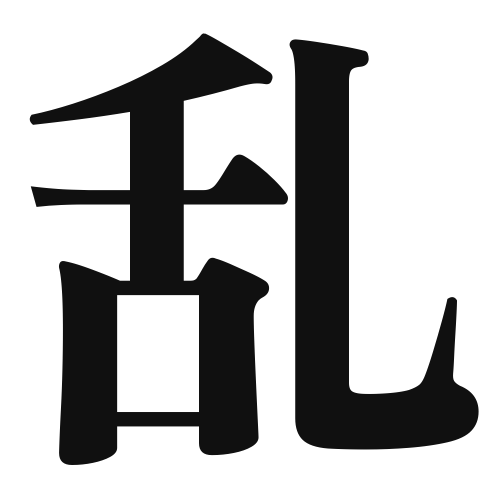1. Overview of Meaning
The kanji “乱” (ran) means “chaos,” “disorder,” or “confusion.” It conveys a sense of disruption or turmoil in various contexts.
2. Formation and Radical
Formation of the Kanji: The kanji “乱” is a compound character (会意文字) that combines elements to convey its meaning. It consists of the radical for “disorder” and a phonetic component that suggests its pronunciation.
Radical: The radical for “乱” is “亻” (the person radical), which often relates to human actions or behaviors, indicating that chaos often involves people.
3. Examples of Usage
Common Words and Phrases: Some frequently used words that include “乱” are:
- 乱れる (midareru) – to be disturbed or disordered
- 乱暴 (ranbō) – violence or roughness
- 混乱 (konran) – confusion or chaos
Example Sentences in Daily Conversation:
- この部屋は乱れている。 (Kono heya wa midarete iru.) – This room is in disorder.
- 彼の乱暴な行動は許されない。 (Kare no ranbō na kōdō wa yurusarenai.) – His violent behavior is unacceptable.
4. Synonyms and Antonyms
Similar Kanji: A kanji with a similar meaning is “混” (kon), which means “mix” or “blend.” While both suggest a lack of order, “乱” emphasizes chaos, whereas “混” can imply a more neutral mixing.
Opposite Kanji: An antonym for “乱” is “整” (sei), which means “to arrange” or “to organize,” indicating order and structure.
5. Cultural and Historical Background
Relation to Japanese Culture: The concept of “乱” is significant in Japanese culture, often reflecting the balance between order and chaos in various aspects of life, including art and philosophy.
Proverbs and Idioms: One common saying is “乱世を生き抜く” (ranse o ikinuku), which means “to survive in chaotic times,” highlighting the resilience required during periods of disorder.
